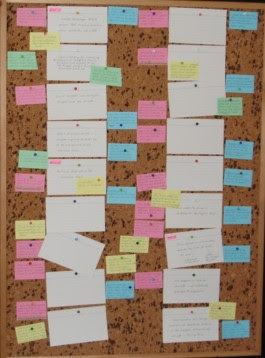
Basically, I'm the sort of person that thinks in pictures. I'm much better at retaining information if I can see it, for example, written down, or if I can visualise it somehow in my head. If I receive complex information only by listening, I often miss or forget some of it. Perhaps this is why I am absolutely awful at remembering names and much better at remembering faces.
Anyway, when I was first starting to try and write a novel, someone somewhere suggested writing the numbers 1 to 20 down on a page and putting the main plots points from your story on the list. I found that approach useful in helping me guage at which point in the story some of my ideas should go, but every time I changed my mind about what was going to happen I had to scribble it all out and start a new list. So I decided to make use of a spare corkboard and some index cards I had tucked away in my house.
Every time I do a plot board, I take a different approach, trying out new things. Here are my original posts (post 1 & post 2) about it. Since then I've tried reducing the plots cards to one central row by snipping the cards in half. It was great to see the flow of the story from the top of the board to the bottom, but I found I didn't have enough room at the edge of each plot card to put all my little "idea" scraps of card. So, this time I've come back to the original format with two rows of full-size index cards containing the main points of my plot. I’ve also messed around with the colour scheme – inspired by the fact I was starting to run out of large pink cards!
White cards – on these I write the central plot points. For my latest book, the first one reads "Fern's friend challenges her to say yes to every question she is asked for a week". This leads to Fern being roped into doing a charity bungee jump because she can't say no, so the next cards reads (not surprisingly) "Fern is tricked into doing a bungee jump”. As you may be able to see if you look closely at the photogrpah, at the moment I know what's happening in the first act and the third act but the middle bit of my story is scarily blank. Whoops.
Pink & blue cards – one of the most important things I use my plot board for is for mapping out the hero and heroine's character arcs and working out what they are feeling/struggling with at each point in the plot. I used to do this all on the same coloured cards, but this time I decided to use pink for the heroine's and blue for the hero's.
Yellow cards – these are my little flashes of inspiration. It could be a point about the character or a possible idea for the plot, the little details that come to me every now and then that help flesh out the story. I tend to use these more for an idea to do with a fixed point in the story, for example: "Josh suggests doing something dangerous and Fern is proved right".
Green cards – these I've used for theme and general points that have relevance throughout the whole story, for example: "Fern finds it hard to live in the moment; Josh finds it hard to do anything but."
I'll probably change it all around next time I do it, but I'm glad I persevered with it for this book. It helped me get a clear idea of the story in my mind as I started to write and I find that scribbling down little ideas and character details and pinning them on my board often sparks my imagination and I come up with even more ideas.

6 comments:
Hi Fiona
Love the cork board and cards idea - this is the technique used by many screenwriters, despite the many storyboard programs available, since, as you say, it is visual, immediate and flexible. It is also an excellent pitching tool - to yourself if nobody else.
http://www.wordplayer.com/columns/wp11.Wind-up.and.Pitch.html
is one example of how top professional screenwriters use them. [This site is an excellent resource if you are not familiar with it by the way]
I tend to use a combination of cards, plus more detailed scene lists in a table in the word document for that story - that way, I can plug in any dialogue etc as I come up with it in one place. And still move things around as needed.
As Jenny Cruisie says, There are many roads to Oz, but the cards certainly work for me.
Many thanks for the reminder and post. Regards, Ray-Anne
I'm struggling so hard with the wip -- due last week -- that I might just adopt this plan so that I can work out what the heck I'm doing!
Gorgeous, talented and organised ... sigh ...
Bitto what Liz says :-)
Ray-Anne, what a useful article! Now I feel like I have permission to get really obsessive with this.
To the Lizs: believe me, this plot board is the only part of my life that is organised at the moment. You should see my ironing pile...
Fiona-- you're a genius and I adore you.
(Am now going to spend the rest of the day tidying up my plot board to make it look as neat as yours-- currently have one idea scribbled down on an old shopping list and pinned up there!!)
Wish I was that organized Fiona! It looks so neat and tidy and colurful and pretty. I want one!!! Ready made please!!!
Ally
Post a Comment